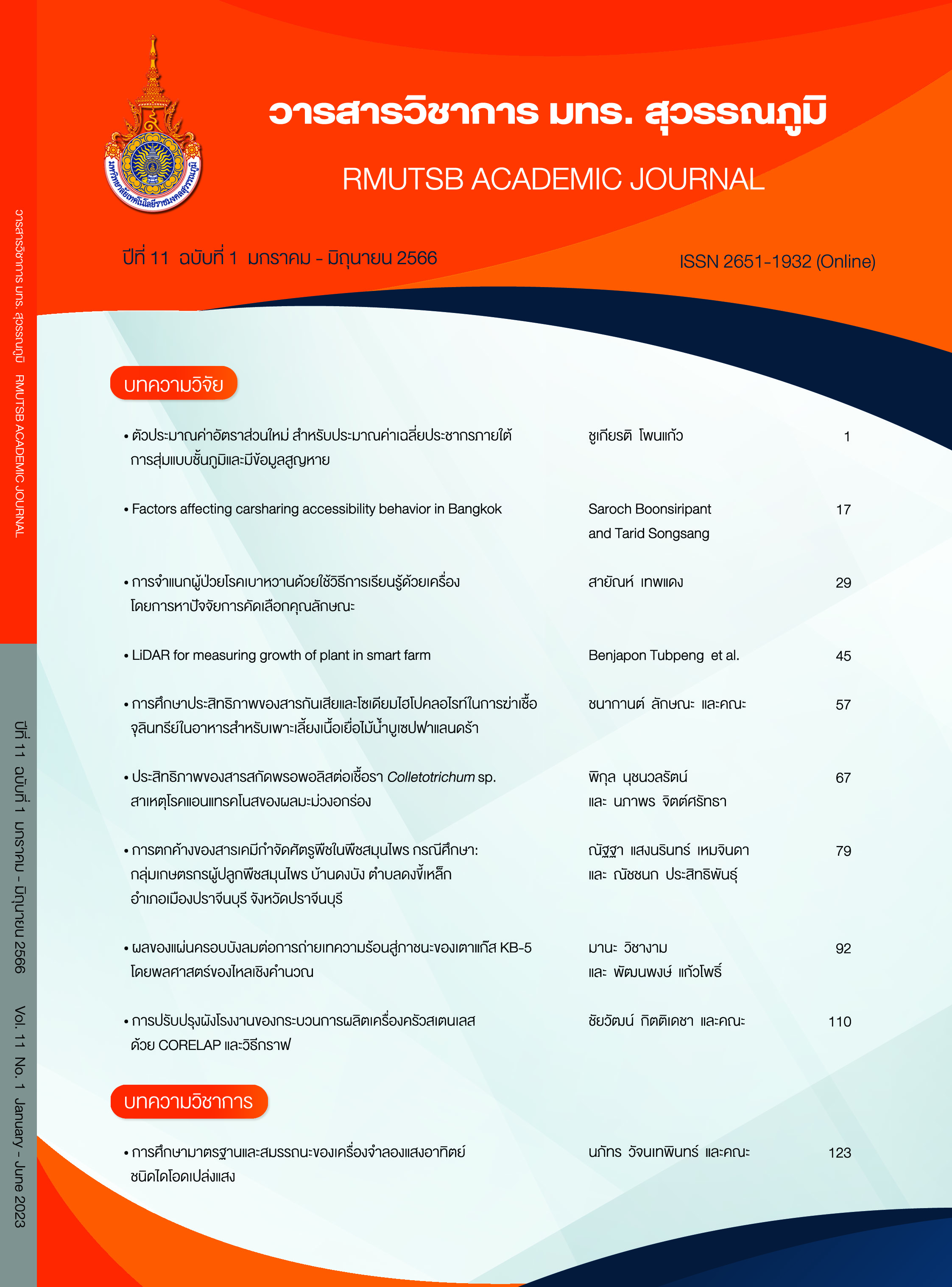ประสิทธิภาพของสารสกัดพรอพอลิสต่อเชื้อรา Colletotrichum sp. สาเหตุโรคแอนแทรคโนสของผลมะม่วงอกร่อง
Main Article Content
บทคัดย่อ
การทดสอบประสิทธิภาพของสารสกัดพรอพอลิสจากชันโรงในเขตอำเภอแหลมสิงห์ อำเภอมะขาม และอำเภอท่าใหม่ จังหวัดจันทบุรี ต่อการยับยั้งการเจริญของเชื้อรา Colletotrichum sp. ที่เป็นสาเหตุโรคแอนแทรคโนสของผลมะม่วงอกร่อง พบว่าสารสกัดพรอพอลิสความเข้มข้น 1, 2, 3 เปอร์เซ็นต์ (w/v) เทียบกับสารโพรคลอราชความเข้มข้น 0.05 เปอร์เซ็นต์ (v/v) ซึ่งมีผลยับยั้งการเจริญของเส้นใย และการงอกของสปอร์ที่แตกต่างกันอย่างมีนัยสำคัญยิ่งทางสถิติ (p<0.01) สารสกัดพรอพอลิสจากอำเภอแหลมสิงห์ความเข้มข้น 3 เปอร์เซ็นต์ สารสกัดพรอพอลิสจากอำเภอท่าใหม่ความเข้มข้น 2 เปอร์เซ็นต์ และสารเคมีป้องกันกำจัดเชื้อราโพรคลอราชความเข้มข้น 0.05 เปอร์เซ็นต์ มีผลยับยั้งการเจริญของเส้นใย และการงอกของสปอร์ได้ดีที่สุดเท่ากับ 100.00 เปอร์เซ็นต์ รองลงมาคือสารสกัดพรอพอลิสจากอำเภอมะขามความเข้มข้น 3 และ 2 เปอร์เซ็นต์ มีผลยับยั้งการเจริญของเส้นใยเท่ากับ 87.11 และ 71.24 เปอร์เซ็นต์ และมีผลยับยั้งการงอกของสปอร์เท่ากับ 93.96 และ 84.66 เปอร์เซ็นต์ ตามลำดับ โดยสรุปสารสกัดพรอพอลิสที่เก็บรวบรวมจากทั้ง 3 อำเภอในจังหวัดจันทบุรี มีประสิทธิภาพในการยับยั้งการเจริญของเชื้อรา Colletotrichum sp. สาเหตุโรคแอนแทรคโนสของมะม่วง จึงควรมีการศึกษาเพิ่มเติมถึงองค์ประกอบทางเคมี และคุณสมบัติในการต้านเชื้อราของพรอพอลิส
Article Details

อนุญาตภายใต้เงื่อนไข Creative Commons Attribution-NonCommercial-NoDerivatives 4.0 International License.
ต้นฉบับที่ได้รับการตีพิมพ์ถือเป็นสิทธิของเจ้าของต้นฉบับและของวารสารวิชาการ มทร.สุวรรณภูมิ เนื้อหาบทความในวารสารเป็นแนวคิดของผู้แต่ง มิใช่เป็นความคิดเห็นของคณะกรรมการการจัดทำวารสาร และมิใช่ความรับผิดชอบของมหาวิทยาลัยเทคโนโลยีราชมงคลสุวรรณภูมิ
เอกสารอ้างอิง
Agrios, G. N. (1997). Plant pathology (4th ed.). London: Academic Press.
Ali, A., Cheong, C. K., & Zahid, N. (2014). Composite effect of propolis and gum arabic to control postharvest anthracnose and maintain quality of papaya during storage. International Journal of Agriculture and Biology, 16(6), 1117-1122.
Ali, A., Chow, W. L., Zahid, N., & Ong, M. K. (2014). Efficacy of propolis and cinnamon oil coating in controlling post-harvest anthracnose and quality of chilli (Capsicum annuum L.) during cold storage. Food and Bioprocess Technology, 7(9), 2742-2748.
Bankova, V., Boudourova, K. B., Popov, S., Sforcin, M., & Funari, S. R. C. (1998). Seasonal variations of the chemical composition of Brazillian propolis. Apidologie, 29, 361-367.
Chaichana, S., & Nalumpang, S. (2007). Detection of fungicide carbendazim resistance in Colletotrichum spp. causing anthracnose disease from mango fruits. Agricultural Science Journal, 38(5), 205-208. (in Thai)
Costantin, C. R., Oliveira, H. G. de, Roese, L. S. M., Pancera, M. R., Silvestre, W. P., Siqueira, G. R., Ferreira, N. R., & Sartori, V. C. (2022). Evaluation of the antifungal activity of propolis extracts from stingless bees on phytopathogenic fungi. Research, Society and Development, 11(16), e445111638445.
Dhingra, O. B., & Sinclair, J. B. (1995). Basic plant pathology methods (2nd ed.). Boca Raton: CRC Press.
Dudoit, A., Cardinault, N., Mertz, C., Chillet, M., & Brat, P. (2021). Antifungal activities of propolis and its main components with an emphasis against phytopathogenic fungi. Journal of Apicultural Science, 65(1), 5-24.
Ecem-Bayram, N., & Gercek, Y. (2019). Appropriate maceration duration for the extraction of propolis. Fresenius Environmental Bulletin, 28(1), 188-192.
Ezazi, R., & Davari, M. (2018). Antifungal activity of ethanolic extract of propolis (EEP) against some postharvest fungi. Biological Control of Pests and Plant Diseases, 7(1), 103-107.
Hossain, R., Quispe, C., Khan, R. A., Saikat, A. S. M., Ray, P., Ongalbek, D., Yeskaliyeva, B., Jain, D., Smeriglio, A., Trombetta, D., Kiani, R., Kobarfard, F., Mojgani, N., Saffarian, P., Ayatollahi, S. A., Sarkar, C., Islam, M. T., Keriman, D., Uçar, A., Martorell, M., Sureda, A., Pintus, G., Butnariu, M., Sharifi-Rad, J., & Cho, W.C. (2022). Propolis: An update on its chemistry and pharmacological applications. Chinese Medicine, 17(1), 100.
Inson, C., & Malaipan, S. (2006). Diversity of stingless bees (Apidae: Trigona spp. and Hypotrigona spp.) and their resin and gum collecting behavior from nature in golden jubilee Thong Pha Phum project, Thong Pha Phum district, Kanchanaburi province (research report). Bangkok: Biodiversity Research and Training Program. (in Thai)
Jenny, F., Sultana, N., Islam, M., Khandaker, M. M., & Bhuiyan, M. A. B. (2019). A review on anthracnose of mango caused by Colletotrichum gloeosporioides. Bangladesh Journal Plant Pathology, 35(1&2), 65-74.
Kongtragoul, P., Nalumpang, S., Miyamoto, Y., Izumi, Y., & Akimitsu, K. (2011). Mutation at codon 198 of tub2 gene for carbendazim resistance in Colletotrichum gloeosporioides causing mango anthracnose in Thailand. Journal of Plant Protection Research, 1(5), 378-384.
Kumar, A. S., Reddy, N. P. E., Reddy, K. H., & Devi, M. C. (2007). Evaluation of fungicidal resistance among Colletotrichum gloeosporioides isolates causing mango anthracnose in Agri Export Zone of Andhra Pradesh, India. Plant Pathology Bulletin, 16, 157-160.
Marino, A. K., Pinsetta Junior, J. S., Magalhães, K. M., & Mattiuz, B. (2018). Chitosan-propolis combination inhibits anthracnose in 'Hass' avocados. Emirates Journal of Food and Agriculture, 30(8), 681-687.
Meneses, E. A., Diego, L., Durango, D. L., Carlos, M., & García, C. M. (2009). Antifungal activity against postharvest fungi by extracts from Colombian propolis. Quimica Nova, 32(8), 2011-2017.
Mohamad Areff, A. A., Mohamed Sidique, S. N., Lani, M. N., & Ahmad, F. T. (2022). Effect of different concentrations of propolis extract coating on postharvest quality of banana artificially inoculated with Colletotrichum gloesporioides. Malaysian Applied Biology, 51(1), 149-156.
Nalumpang, S., Miyamoto, Y., Miyake, C., Izumi, Y., Akitmitsu, K., & Kongtragoul, P. (2010). Point mutations in the beta-tubulingene conferred carbendazim-resistant phenotypes of Colletotrichum gloeosporioides causing nam dok mai mango anthracnose. Journal of Agricultural Technology, 6(2), 365-378.
Nuchnuanrat, P., & Napaporn, J. (2021). Evaluation of fungicide carbendazim resistance in Colletotrichum gloeosporioides causing anthracnose disease of mango cv. Aokrong in Chanthaburi province. RMUTSB Academic Journal, 9(2), 164-173.
Omar, N. A., Sidique, S. N. M., & Ahmad, F. T. (2020). Antifungal properties of water extract propolis coating against anthracnose (Colletotrichum gloeosporioides) disease on strawberry (Fragaria anannassa). Malaysian Applied Biology, 49(4), 253-260.
Phoonan, W., & Noppakun, K. (2021). Antifungal activity of stingless bee, Tetragonula pagdeni (Schwarz), propolis extracts against tangerine green mold rot. Khon Kaen Ariculture Journal, 49(3), 691-700. (in Thai)
Rodrigues, M. L. M., Mizobutsi, E. H., Lima Prates, P. J., Leite Duarte, P. V., Ferreira Ribeiro, R. C., Silva Pinheiro, J. M. da, Mizobutsi, G. P., Fernandes, M. B., & Silva, L. S. (2019). Phosphite-based products in the in vitro Colletotrichum musae control. Journal of Experimental Agriculture International, 33(4), 1-9.
Waramit, W., & Charoensuk, K. (2016). Effective on Pak-wan tree (Sauropus androgynus) extraction to bacterial inhibition of Salmonella pullorum in native chicken. RMUTSB Academic Journal, 4(2), 120-128.
Xu, X., Pu, R., Li, Y., Wu, Z., Li, C., Miao, X., & Yang, W. (2019). Chemical compositions of propolis from China and the United States and their antimicrobial activities against Penicillium notatum. Molecules, 24(19), 3576.


